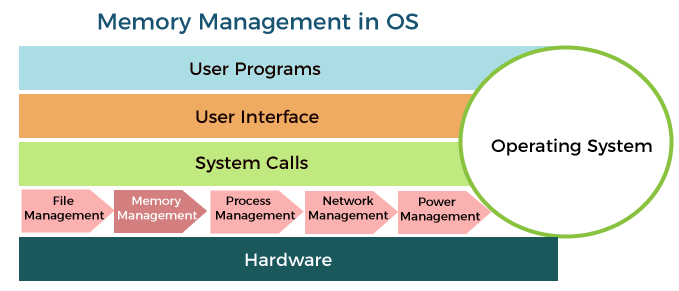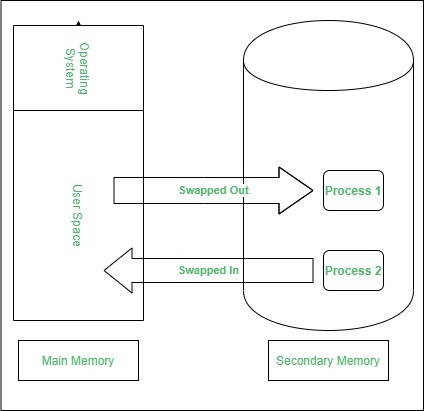Physical address space is divided into fixed size blocks called frames. Memory management enables the execution of multiple processes at the same time in the computer system.
This includes granting different levels of access to files and assigning roles for specific users.

. This increases efficiency as the right user receives the correct file. The task of placing the pages or blocks of data from the hard disk to the main memory is called swapping in. It is the process of maintaining folders documents and multimedia into categories and subcategories as desired by a user.
Then came the Garbage Collection in the Microsoft NET common language runtime environment which completely relived the developer from the task of all this memory management. Fundamental aspects of file management are organizing labeling and classifying computer data. Memory manager permits computers with a small amount of main memory to execute programs larger than the size or amount of available memory.
Answer 1 of 2. They are found alongside process management and system calls. Next we will synchronize cached writes to persistent storage rootcentos-8 sync.
Memory Management is an essential function of the Operating System. For example multiple processes may use the same system file and it is natural to load one copy of the file in main memory and let it shared by those processes. Memory Management in Operating Systems Simple Explanation.
Operating System - Memory Management. Memory management plays an important part in operating system. The term Memory can be defined as a collection of data in a specific format.
It deals with memory and the moving of processes from disk to primary memory for execution and back again. It does this by moving information back and forth between primary memory and secondary memory by using the concept of swapping. Memory management is the functionality of an operating system which handles or manages primary memory and moves processes back and forth between main memory and disk during execution.
However the irony is the developers were still not happy. Address translation is actually done by the MMU Memory Management System by using a page table as shown in the figure below. A static array has fixed size.
To demonstrate this in Linux memory management we will take a very simple example. It is the most important function of an operating system that manages primary memory. The pages are located at different memory locations in the memory.
Utilization of memory space Memory management shares the same memory space among different processes. The memory manager scans the whole list and takes the smallest hole that will fit the process. For example multiple processes may use the same system file and it is natural to load one copy of the file in main memory and let it shared by those processes.
It is the task of memory management to allow controlled access to the shared areas of memory without compromising the protection. A companys security strengthens with modern file management. More than one program can run at the same time.
A file management system allows admins to set limits permissions and roles for files. We cannot increase its size to handle situations requiring more elements. Memory management requires that the programmer provides ways to dynamically allocate portions of memory to programs when requested and free it for reuse when it is no longer needed.
This technique helps in keeping the track of each and every memory location whether the memory location is allocated. More than one document can be opened at the same time. Computer memory must be managed to ensure that.
Next we will clear the buffers and cache. All of these basic facilities help the kernel to manage the computers resources as well as allowing other programs to use and run these resources. One method of memory.
File management helps to eliminate clutter so that a user can. Memory Management is the process of coordinating and controlling the memory in a computer Blocks are assigning portions that are assigned to various running programs in order to optimize the overall performance of the system. This concept has an advantage.
Memory Management in Operating System. The logical address space is divided into fixed size blocks called pages. Best fit is slower than first fit because it must search the whole list every time it is called.
I will create a small file with some random text. Of all of the technologies to be found in NET the most controversial seems to be garbage collection. Some basic concepts related to.
Memory Management is the process of controlling and coordinating computer memory assigning portions known as blocks to various running programs to optimize the overall performance of the system. Rootcentos-8 echo Understanding Linux memory management my_file. Memory management keeps track of each and every memory location regardless of either it is allocated to some process or it.
As a result we will tend to declare larger arrays than required leading to wastage of memory. File management is the storing naming sorting and handling computer files. Hence we can perform many tasks at a particular memory space.
This comes under one of the two main functions of an Operating System resource management. It is the task of Memory management to allow controlled access to the shared areas of memory without compromising the protection. Main memory RAM is where most of the applications run.
In any advanced computer system where more than a single process might be running at any given point in time this is critical. It is one of the main things people look for when buying a new. It helps processes to move back and forward between the main.
Swapping involves performing two tasks called swapping in and swapping out. It is used to store instructions and processed data. Worst Fit The memory manager scans the whole list and takes the largest available hole so that the hole broken will be big enough to be useful.
Swapping is the technique used by an operating system for efficient management of memory space of a computer system. The memory manager is responsible for protecting the memory allocated to each. Memory in the system is dynamically allocated depending on the requirement and it is freed up when the process no longer requires the memory thus alloxcating that slot of memory to another.
Within the kernel of a computer memory management and device management are considered as two different kernel basic facilities. One of the key functions of the memory management system in a computer is assigning memory to a number of different running programs to keep the performance of the system stable. The memory comprises a large array or group of words or bytes each with its own location.
The Importance of Memory Management. The primary motive of a computer system is to execute programs. The above figure gives an outlook of memory management of the operating system.
This allocation is done in memory exclusively allocated to a program which is often limited in size.

Memory Management In Os Contiguous Swapping Fragmentation


0 Comments